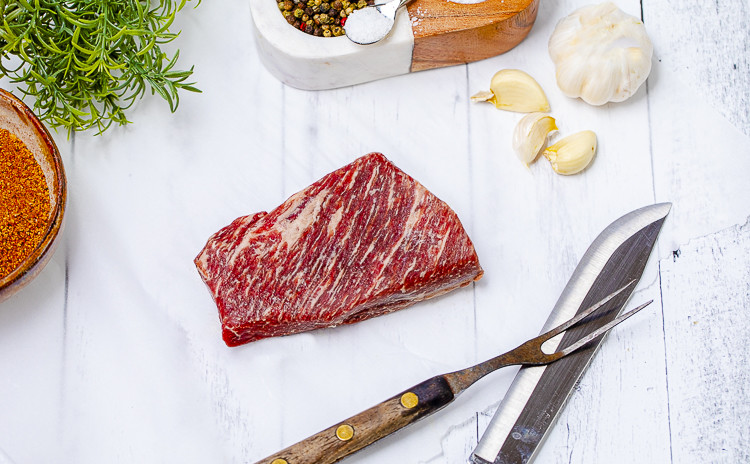Everything you need to know about Wagyu Beef and Pellet Smokers!
posted on
March 20, 2019

Basic Info:
There are many different types of grills and smokers, but because the BBQ Pit Stop only carries Pellet Smokers, I'll stick with guidelines for pellet smokers in this blog.
If you're new to the game (Like I was), you'll need to know that smokers can also be grills! Anything from 150-350 degrees is smoking. Once you go above 350 degrees, it's considered grilling. Once you have all your materials, smoking is a very easy process.
Especially if you have a Green Mountain Smoker with the wifi connection, which allows you to actually get notifications on the temp of your meat and adjust when necessary using your phone remotely!
Things you'll need:
1.Pellets! See more on how to choose your pellets here.
2.Wagyu roast, brisket, ribs.. we'll start out with the bigger cuts and work our way down to steaks for the more advanced techniques.
3.Optional: BBQ Pit Stop seasoning. They have lots of Sucklebuster Seasonings that pair well with Wagyu Beef. My favorite is the 1836 Beef Rub!

Arm Roast:
On 3/16/19: We featured an arm roast (2-3 lbs), so that's the first thing I'll walk you through here.
Once the roast is thawed, apply whatever seasonings are your favorite. The cool thing about Wagyu is that all you really need is a little salt and pepper and the flavor is there naturally. But if you're a sucker for seasoning, it certainly won't hurt to add a little bit. I'd recommend experimenting with it and doing part with- part without seasoning (just salt and pepper) and see which you like better!
As you let the seasoning set in, set your smoker to 200 degrees. We used the Maple-Hickory-Cherry (also known as the Completion blend) pellets for this and it turned out fantastic! We'll go more in depth on choosing the right pellets in another blog post so stay tuned for that.
Once your smoker reaches 200 degrees, you can throw on the roast. The pellet grill should do a good job of maintaining temp for you so you're not babysitting the whole time. After about 2 hours, it's time to flip. Let smoke for another 2 hours and remove the roast from the smoker.
Most importantly,
Once the roast is done, patience is key. It makes all the difference to wrap your roast in a towel or foil and let sit for at least 30 mins after cooking. This process ensures all the juices stay in as to not dry out the roast you just spent 4 hours cooking.
After waiting 30 mins, you can unwrap the roast and enjoy!

Skirt Steak
On 3/24/19: We featured a reverse-sear Skirt Steak that turned out AMAZING, so let me walk you through everything we did there! The reverse sear is a great way to get that smokey flavor while still getting that subtle char from the grill. If you don't have a smoker, you can replicate this process using an oven and a cast iron pan/grill. You'll want to limit oven time to about 30 mins or until steak is 120 degrees (for medium rare) and reduce pan time to 60-90 seconds per side.
We started off by setting the Green Mountain smoker to 160 degrees, once again using the Maple-Hickory-Cherry pellets. Once thawed, we put the steak on, lightly seasoned one side, and let it smoke for an hour, flipping half way through and seasoning the other side. Once it was done smoking, we took the steak off the grill while the temp got up to 400 degrees. Once the grill reached 400, we put the steak back on for another 12 mins, flipping at about 7 mins.
Once it was done grilling, we let it sit for about 5 mins before digging in! Let's just say the customers who happened to come in when this baby was done were lucky ducks!
Brisket:
We haven't done this one yet, but here's a little how to in case you need some guidance:
Cook time: 6-8 hrs (our briskets are cut down to 1/4's so they're a little smaller and don't take as long to smoke)
Before getting started, you'll want to trim the cold brisket to remove excess fatty bits. Allow brisket to come to room temp. Generously season whole brisket with your desired rub. The larger and less trimmed the brisket, the longer it will take.
Heat smoker to 250℉. Place brisket in smoker fat side down and cook until internal temp. reaches 170℉(about 3 hrs).
When brisket reaches 170℉ a nice crust will form on the outside of the brisket. This is also known as the bark. Be careful not to allow the crust to become too charred. To protect brisket from becoming burnt, remove brisket from smoker, wrap in foil or butcher paper and put back on smoker.
Remove brisket from heat when internal temp. reaches 197-200℉. (Approx. 2-3 more hours).
Wrap in thick, heavy blanket and let rest for 3 hrs. Brisket can also be wrapped in towels and placed in a cooler during this time.
Remove brisket from towels or blanket. Slice, add sauce and serve!




